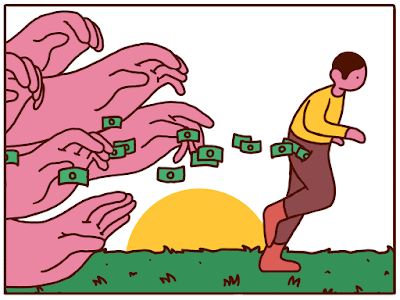Running the Economy - III
This is the third episode of you trying to understand the process comprising an economy.
Productivity matters most in
the long run, but credit matters most in the short run. This is because
productivity growth doesn't fluctuate much, so it's not a big driver of
economic swings. Debt is — because it allows us to consume more than we produce
when we acquire it, and it forces us to consume less than we produce when we
pay it back. Debt swings occur in two big cycles. One takes about 5 to 8 years,
and the other takes about 75 to 100 years. While most people feel the swings,
they typically don't see them as cycles because they see them too up-close --
day by day, week by week.
 |
| Bloomberg |
In this chapter, we are going
to step back and look at these three big forces and how they interact to make
up our experiences. As mentioned, swings around the line are not due to how
much innovation or hard work there is, they're primarily due to how much credit
there is.
Let's imagine an economy
without credit. In this economy, the only way I can increase my spending is to
increase my income, which requires me to be more productive and do more work.
Increased productivity is the
only way for growth. Since my spending is another person's income, the economy
grows every time I or anyone else is more productive. If we follow the
transactions and play this out, we see a progression like the productivity
growth line. But because we borrow, we have cycles. This isn't due to any laws
or regulations, it's due to human nature and the way that credit works.
Think of borrowing as simply a way of pulling spending forward. To buy something you can't afford, you need to spend more than you make. To do this, you essentially need to borrow from your future self. In doing so you create a time in the future that you need to spend less than you make to pay it back. It very quickly resembles a cycle. Anytime you borrow you create a cycle.? This is as true for an individual as it is for the economy. This is why understanding credit is so important because it sets into motion a mechanical, predictable series of events that will happen in the future. This makes credit different from money. Money is what you settle transactions with.
When you buy a beer from a bartender with cash, the transaction is settled immediately. But when you buy a beer with credit, it's like starting a bar tab. You're saying you promise to pay in the future. Together you and the bartender create an asset and a liability. You just created credit. Out of thin air. It's not until you pay the bar tab later that the asset and liability disappear, the debt goes away, and the transaction is settled.
The reality is that most of
what people call money is credit. The total amount of credit in India is about ₹
26.6 Lakh crore and the total amount of money is only 10%. Remember, in an
economy without credit the only way to increase your spending is to produce
more. But in an economy with credit, you can also increase your spending by
borrowing. As a result, an economy with credit has more spending and allows
incomes to rise faster than productivity over the short run, but not over the
long run. Now, don't get me wrong, credit isn't necessarily something bad that
just causes cycles.
It's bad when it finances
over-consumption that can't be paid back. However, it's good when it
efficiently allocates resources and produces income so you can pay back the
debt. For example, if you borrow money to buy a big TV, it doesn't generate
income for you to pay back the debt. But if you borrow money to buy a tractor —
and that tractor lets you harvest more crops and earn more money — then you can
pay back your debt and improve your living standards.
In an economy with credit, we
can follow the transactions and see how credit creates growth. Let me give you
an example: Suppose you earn ₹100,000 a year and have no debt.
You are creditworthy enough
to borrow ₹10,000 - say on a credit card - so you can spend ₹110,000 even
though you only earn ₹100,000. Since your spending is another person's income,
someone is earning ₹110,000. A person earning ₹110,000 with no debt can
borrow ₹11,000, so he can spend ₹121,000 even though he has only earned ₹110,000.
His spending is another person's income, and by following the transactions we
can begin to see how this process works in a self-reinforcing pattern. But
remember, borrowing creates cycles, and if the cycle goes up, it eventually
needs to come down.
This leads us into the
Short-Term Debt Cycle. As economic activity increases, we see an expansion -
the first phase of the short-term debt cycle. Spending continues to increase,
and prices start to rise. This happens because the increase in spending is
fuelled by credit - which can be created instantly out of thin air.
We make your 2 minutes cherishable- Finbolts
Until next share this with your friends on - Facebook Instagram WhatsApp.
Finnomy
👌Best explainations , very easy to understand bro
ReplyDelete